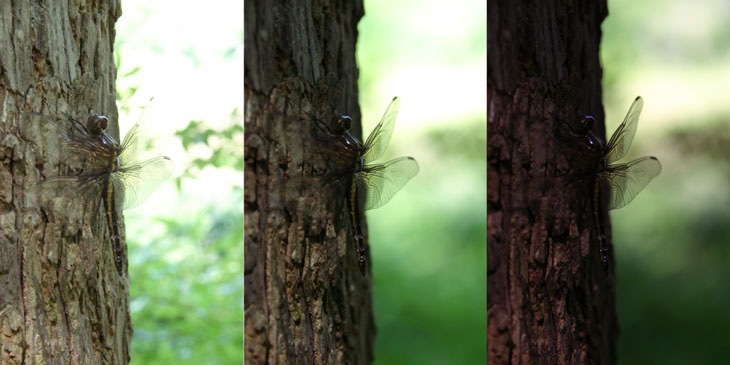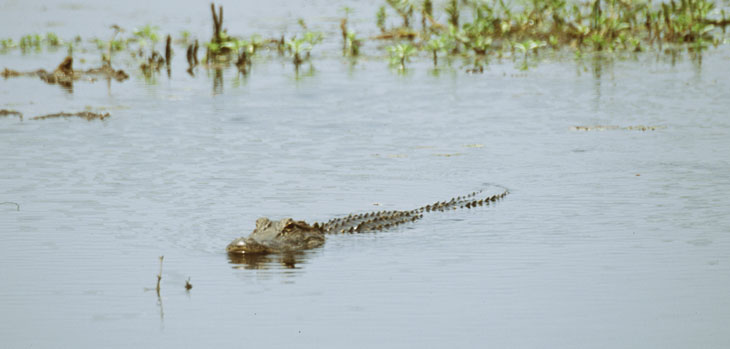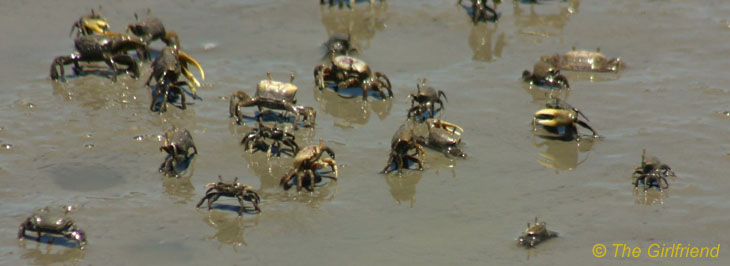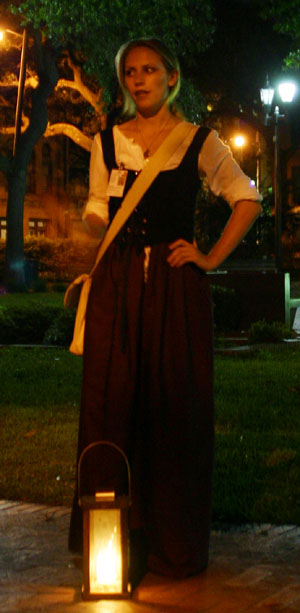
One of the traits of photography, regardless of film or digital, is that it does not capture the range of light intensity that our eyes do. This makes photographs display increased contrast, and often it destroys detail or color rendering in either highlights or shadow areas, or both. It’s one of the trickiest things about obtaining a proper exposure, and frequently requires some careful adjustments or supplemental lighting. This is most especially true with images showing both sunlit and shadowed areas, or when aiming into the light.
At top is a recent example from our trip to Hilton Head, two images taken a second apart. You can see that they’re aimed slightly differently, and this meant that the camera was obtaining an exposure reading from areas of intensely different light levels. The sky takes on a nice, rich and detailed appearance in one, but loses all foreground detail, while the other washes out detail from the sky (both, by the way, taken without compensation on Canon’s Evaluative Metering setting.) This is typical, and represents the choices that photographers have had to make for decades, even with newer films and digital sensors.
 There are tricks that can be used to help alleviate this, but often the result is unnatural-looking and awkward. There are lens filters called graduated neutral density, which are basically tinted through half of the glass, the remainder being clear – the tinted half goes over the brighter portion of the image and is used to reduce the light level closer to that of the darker portions. The problem with these is that one rarely has a nice straight horizon, and when it is present, the fuzzy line between the tint and clear portions of the filter would show unnatural transitions in the resulting image. Most photographers left such filters alone and simply avoided the situations that suffered from too much contrast, watching for conditions that alleviated the problem.
There are tricks that can be used to help alleviate this, but often the result is unnatural-looking and awkward. There are lens filters called graduated neutral density, which are basically tinted through half of the glass, the remainder being clear – the tinted half goes over the brighter portion of the image and is used to reduce the light level closer to that of the darker portions. The problem with these is that one rarely has a nice straight horizon, and when it is present, the fuzzy line between the tint and clear portions of the filter would show unnatural transitions in the resulting image. Most photographers left such filters alone and simply avoided the situations that suffered from too much contrast, watching for conditions that alleviated the problem.
Another way to control contrast was done in the darkroom with techniques called dodging and burning, which means selectively lightening or darkening, respectively, the portions of the frame that required it. This was (and is, for those who still pursue the wet print, which is really quite fun) useful only when the negative captured the necessary details in the first place, but since the issue was the limit of film’s dynamic range, you can’t reproduce detail that does not exist in the negative. If the bright areas have bleached out too far, there’s nothing to work with.
Enter the digital darkroom, and a technique now included in many programs called high dynamic range (often abbreviated HDR.) The basic method of HDR is to take two examples of the same scene at different exposure settings, one that captures the brighter areas (highlights) and another that captures the darker areas (shadows.) A tripod is recommended, since the images should match as close as possible, but the resulting images are digitally blended to capture the best of both. Many software packages offer this now, but I’ve done it here manually since I’m using an older program (Adobe Photoshop 6.0) that’s been serving me just fine.
Blending the details just right is actually tricky, and easy to screw up (like in the image above.) Sometimes the results are fine for those who aren’t used to evaluating images, but are plainly visible to anyone that’s had to cope with disparate light levels, and are distinct evidence of digital manipulation. In other words, don’t think everyone is going to be fooled. Having been shooting since before digital existed at all, I’ve watched the change of attitudes towards this with some amusement. When it first arrived on the scene, many photographers treated digital as a gimmick, permitting a “bad” photo to be corrected without having to learn proper photographic techniques. In a way, this was true, but not even close to the extent that it was disparaged for it. A good starting point was necessary, since digitally correcting a truly bad photo takes its own set of skills, one possessed by far fewer people than could simply take a good image in the first place, not to mention a whole boatload of time. But as I’ve watched, HDR has started to become an “acceptable” technique among professionals, rather than a gimmick.
 Now, I’m torn on the issue, personally. Generally, the resulting image represents something not seen in nature, presenting light conditions that really don’t exist, and often cannot. In these times when removing people, trash, or distractions from a scene can cost a photojournalist their career (not just their job,) it seems hypocritical to freely accept a blatant technique of selective imaging. And one of the skills that I’ve learned, and teach, is to work with the light that’s there, or find ways around it. The really good images from the top photographers are often the result of careful planning and being on location for just the right moments – it’s what makes those images special. The prevalence of altered images makes these accomplishments cheaper, and indeed hurts all really good images. It takes virtually nothing anymore for someone to cry “Photoshop!” at an image, even one that saw no such editing, because the media is saturated with alterations, and this makes those special efforts barely worth it anymore.
Now, I’m torn on the issue, personally. Generally, the resulting image represents something not seen in nature, presenting light conditions that really don’t exist, and often cannot. In these times when removing people, trash, or distractions from a scene can cost a photojournalist their career (not just their job,) it seems hypocritical to freely accept a blatant technique of selective imaging. And one of the skills that I’ve learned, and teach, is to work with the light that’s there, or find ways around it. The really good images from the top photographers are often the result of careful planning and being on location for just the right moments – it’s what makes those images special. The prevalence of altered images makes these accomplishments cheaper, and indeed hurts all really good images. It takes virtually nothing anymore for someone to cry “Photoshop!” at an image, even one that saw no such editing, because the media is saturated with alterations, and this makes those special efforts barely worth it anymore.
At the same time, how much different is this from selecting highly saturated or low contrast films, or using fill-flash and reflectors, all common traditional techniques? At what point does an image cross the line from representing “reality”… or has it ever? When I scan even a film image, is correcting the color cast that the film displays cheating or not? Who should judge, and what criteria should they use? Personally, I treat editing very seriously, and only do subtle color and contrast tweaks overall, things that could be done routinely in the darkroom without special preparations. I occasionally do more serious work, and have liked the results, but in my mind they are always gimmicks, and achieving the effect without software is much more satisfying. And, I always represent manipulated images as such.
Now, a quick lesson. What makes the bad image (to the right of the text, above) not work? Notice the apparent light levels from the sky and the waves, which almost seem to match. The water takes on a glow from “within,” because it obviously cannot be reflecting the sky. Reflections in water are always darker than what they’re reflecting. Even the glitter trail, the reflection of the sun in the wet sand, is brighter than the sun itself. Especially telling is how the clouds right on the horizon get lighter and less contrasty, for no apparent reason. This is what a graduated neutral density filter often looks like, or too abrupt a transition between the blended frames (the culprit here.)
Alternately, the better version (on the left of the text above) seems much less unnatural. The transition, the blend between the two images, actually extends from middle of the cloud pack down to the clump of beach grass on the left – this kept the waves more accurately dark against the sky, and made for an almost invisible transition. The sand getting just a little darker with “distance” (actually towards the center of the frame, vertically) seems completely natural. But, did you catch the faint doubling of the couple in the frame? ;-) (This would have been easy to fix, but I liked the subtle telltale for my purposes here.)
Let’s look at a different example, one that, to me, is more acceptable to use. Feel free to argue with me about it if you like ;-)

You may recognize the dragonfly, and I did mention that I purposefully took several frames just to experiment with this. The difference in exposure between the left and right frames is roughly three stops, which is significant. I chose to blend three frames for this because of the difference in the background light levels – notice the rich green low in the center frame, but the highlights get blown out too much. At the same time, the depth-of-field in the image on the left is actually too high, making the background speckled rather than blurred.
 So with those, you can see what got used from each in the resulting image here. Notice how the background blends easily and, while there’s still a blowout of detail into pure white, it’s much less noticeable and harsh. The wing details remain present and sharp, and nothing has gone too dark. Now, in these conditions, I would have been unlikely to get the depth-of-field looking this way, since the depth needed to get the wings on both sides would have rendered more detail from the background, but this is hardly something that jumps out even at experienced photographers and editors. Capturing lighting like this in nature is difficult, since bright sunlight falling on the dragonfly would be necessary to keep it so close in level to the background, but such light would increase the contrast and the shadows of the bark. I could accomplish it easily with a strobe unit and softbox (I had the strobe, and even used it for one image in the other post, but not the softbox.) The result doesn’t look unnatural, and doesn’t represent impossible conditions, even if they would be rare. Still, I prefer to leave the HDR to others.
So with those, you can see what got used from each in the resulting image here. Notice how the background blends easily and, while there’s still a blowout of detail into pure white, it’s much less noticeable and harsh. The wing details remain present and sharp, and nothing has gone too dark. Now, in these conditions, I would have been unlikely to get the depth-of-field looking this way, since the depth needed to get the wings on both sides would have rendered more detail from the background, but this is hardly something that jumps out even at experienced photographers and editors. Capturing lighting like this in nature is difficult, since bright sunlight falling on the dragonfly would be necessary to keep it so close in level to the background, but such light would increase the contrast and the shadows of the bark. I could accomplish it easily with a strobe unit and softbox (I had the strobe, and even used it for one image in the other post, but not the softbox.) The result doesn’t look unnatural, and doesn’t represent impossible conditions, even if they would be rare. Still, I prefer to leave the HDR to others.
By the way, while I don’t really consider this a knockdown or particularly compelling image (I hate that the wings closest to us disappear among the bark,) I wanted to point out something to you. See the dark patch of the middle background? I intentionally positioned the camera in height so that this would fall between the wings, rather than touching or overlapping them. Very subtle, but it’s little interactions between the subject and background that can affect how well the image comes off, so keep your eye on such things. It was a simple matter to bump the tripod up a little to accomplish this, and it works much better. My students hate it when I’m this nitpicky on their images (I’m the same with my own,) but while I don’t really believe in the “perfect image,” I think trying to get as close as you can is the only thing that makes one improve.


















































 We know that birds can imprint readily on whoever feeds them from birth, and spiders have much teenier brains, so it’s safe to assume that their “pile on mom” instinct is extremely primitive.
We know that birds can imprint readily on whoever feeds them from birth, and spiders have much teenier brains, so it’s safe to assume that their “pile on mom” instinct is extremely primitive. So this morning I was checking out a new area for nature photography near me, supposedly before the day got too hot (I was wrong.) I wasn’t in search of any particular subject matter, just whatever opportunities arose. When I stumbled across (well, not literally) a dragonfly perched low on a tree trunk right alongside the path, wings still not dried from its new molt and transformation from larval stage, I sat down and start taking photos of it. For forty five minutes.
So this morning I was checking out a new area for nature photography near me, supposedly before the day got too hot (I was wrong.) I wasn’t in search of any particular subject matter, just whatever opportunities arose. When I stumbled across (well, not literally) a dragonfly perched low on a tree trunk right alongside the path, wings still not dried from its new molt and transformation from larval stage, I sat down and start taking photos of it. For forty five minutes.
 “Transitional forms,” as that video clip demonstrated (I apologize for that, but Comfort and Cameron are the most astoundingly bad promoters of creationism,) is another aspect grossly misunderstood. Nobody in their right mind ever proposes one species turning into another existing species; what the evolutionary change provides for is an entirely new species. Religious apologists proclaiming that the world contains no “combination” species are simply demonstrating their profound ignorance, dismally, since this information is readily available even online. If you really want to see a transitional species, look no further than penguins, birds that cannot fly but swim exceptionally well – preyed on, no less, by sea lions, mammals that lack feet anymore (though their skeleton betrays the ancient evidence of them) that also swim better than they walk, yet still have to breathe air, not water. Both of these species, and many more besides, are completely pointless and inept from a design standpoint, and would be much better off with traits that fish have, like gills and scales. They possess the traits that they do because selection makes them work from the changes that the species have undergone in times past. Smaller wings does not do much for flying birds, but they offer an advantage to swimming birds. Fins would be better, but fish have had a much longer time to specialize in their swimming appendages, so penguins and sea lions cope with modified limbs from times when they were flying or walking species.
“Transitional forms,” as that video clip demonstrated (I apologize for that, but Comfort and Cameron are the most astoundingly bad promoters of creationism,) is another aspect grossly misunderstood. Nobody in their right mind ever proposes one species turning into another existing species; what the evolutionary change provides for is an entirely new species. Religious apologists proclaiming that the world contains no “combination” species are simply demonstrating their profound ignorance, dismally, since this information is readily available even online. If you really want to see a transitional species, look no further than penguins, birds that cannot fly but swim exceptionally well – preyed on, no less, by sea lions, mammals that lack feet anymore (though their skeleton betrays the ancient evidence of them) that also swim better than they walk, yet still have to breathe air, not water. Both of these species, and many more besides, are completely pointless and inept from a design standpoint, and would be much better off with traits that fish have, like gills and scales. They possess the traits that they do because selection makes them work from the changes that the species have undergone in times past. Smaller wings does not do much for flying birds, but they offer an advantage to swimming birds. Fins would be better, but fish have had a much longer time to specialize in their swimming appendages, so penguins and sea lions cope with modified limbs from times when they were flying or walking species. We weren’t far from shore, either, and the view was almost as good from there, though it appeared to be private beaches. There was plenty of dolphin activity in our area, and in every direction – we even got glimpses of a “baby” dolphin (years in wildlife rehab make me put that in quotes, since the more appropriate term is “juvenile,” it just doesn’t give the right impression.) Speaking of juveniles, the young children on our boat were a hoot, excitedly pointing out every last appearance, though occasionally they were a bit misleading. “Mom! Look!” they would cry, and as nearly everyone on the boat craned around to see where they were pointing, they’d exclaim, “Jellyfish!”
We weren’t far from shore, either, and the view was almost as good from there, though it appeared to be private beaches. There was plenty of dolphin activity in our area, and in every direction – we even got glimpses of a “baby” dolphin (years in wildlife rehab make me put that in quotes, since the more appropriate term is “juvenile,” it just doesn’t give the right impression.) Speaking of juveniles, the young children on our boat were a hoot, excitedly pointing out every last appearance, though occasionally they were a bit misleading. “Mom! Look!” they would cry, and as nearly everyone on the boat craned around to see where they were pointing, they’d exclaim, “Jellyfish!”

 Returning to our rooms, I came in quietly and set the alarm to get up before sunrise, because that’s what you do – not to keep repeating this point for anyone who’s been reading a while, but the best light is near sunrise and sunset, so if you’re serious about nature photography, you arrange your shooting schedule around these whenever possible. I had planned on slipping out without disturbing anybody, but The Girlfriend heard the alarm and roused herself to come along while our friends continued snoozing, which was fine by me.
Returning to our rooms, I came in quietly and set the alarm to get up before sunrise, because that’s what you do – not to keep repeating this point for anyone who’s been reading a while, but the best light is near sunrise and sunset, so if you’re serious about nature photography, you arrange your shooting schedule around these whenever possible. I had planned on slipping out without disturbing anybody, but The Girlfriend heard the alarm and roused herself to come along while our friends continued snoozing, which was fine by me.

 The most common subjects we saw in this refuge were the purple gallinules (Porphyrio martinica,) where the males displayed rich, iridescent blue/purple coloring, but the females a very drab black. About the size of bantam chickens, we had arrived at fledgling time, and numerous mothers were out with their chicks showing them how to forage for food. Most areas of the walking path were shrouded from the adjoining channel by tall cattail reeds, and it often required shooting through a screen of them. The gallinules frequently called to one another, as well as maintaining quieter clucks to keep the chicks oriented with their mother. The Girlfriend and I had witnessed the same thing in the NC mountains with the wild turkeys there; the mothers provide a near constant series of quiet, muttering calls which don’t carry very far, which the chicks know to keep within earshot. These calls are faint enough to avoid attracting attention from greater than 15 meters (50 feet) or so. If the chicks stray beyond hearing range, they frantically start a louder call to try and find mama.
The most common subjects we saw in this refuge were the purple gallinules (Porphyrio martinica,) where the males displayed rich, iridescent blue/purple coloring, but the females a very drab black. About the size of bantam chickens, we had arrived at fledgling time, and numerous mothers were out with their chicks showing them how to forage for food. Most areas of the walking path were shrouded from the adjoining channel by tall cattail reeds, and it often required shooting through a screen of them. The gallinules frequently called to one another, as well as maintaining quieter clucks to keep the chicks oriented with their mother. The Girlfriend and I had witnessed the same thing in the NC mountains with the wild turkeys there; the mothers provide a near constant series of quiet, muttering calls which don’t carry very far, which the chicks know to keep within earshot. These calls are faint enough to avoid attracting attention from greater than 15 meters (50 feet) or so. If the chicks stray beyond hearing range, they frantically start a louder call to try and find mama.
 Once again, the fiddler crabs were in evidence, and I don’t say this lightly – it was the largest collection I’ve ever seen. The number of them was so great that one could be excused for imagining they were only stubs of plants or something, and being diminutive and off the trail a short ways, they could be totally missed if someone wasn’t being alert. I suspect I’ve mentioned before that I like crabs, and could have spent no small amount of time right there – I also could have gotten really filthy doing so, trying to get up close to a subject standing not two centimeters tall that liked soft mud. Decorum won out, however, as the patience of my friends and the prospect of getting back into their car covered in black mud prevented me from indulging in my native instincts. I still spent a few minutes chasing them and watching their antics.
Once again, the fiddler crabs were in evidence, and I don’t say this lightly – it was the largest collection I’ve ever seen. The number of them was so great that one could be excused for imagining they were only stubs of plants or something, and being diminutive and off the trail a short ways, they could be totally missed if someone wasn’t being alert. I suspect I’ve mentioned before that I like crabs, and could have spent no small amount of time right there – I also could have gotten really filthy doing so, trying to get up close to a subject standing not two centimeters tall that liked soft mud. Decorum won out, however, as the patience of my friends and the prospect of getting back into their car covered in black mud prevented me from indulging in my native instincts. I still spent a few minutes chasing them and watching their antics.
 Countless other species were raising their young there too. A couple of fledgling tricolor herons (Egretta tricolor,) seen at right, were flying heavily from perch to perch and making a ridiculous amount of noise, upset because their mother was trying to convince them to find their own food. A few anhinga (Anhinga anhinga) youngsters could be seen, and we spotted double-crested cormorants, great egrets, wood ducks, black-crowned night herons, and at least one example each of little blue and green herons. The activity was constant, one of those situations where you can only look in one direction at a time and thus know you’re missing something in another (that’s why there were three of us shooting.) Since The Girlfriend’s camera was being balky, she used my digital while I shot film, and so she got to be a bit more serious in chasing subjects – it convinced her to invest in her own DSLR now (and will have a significant upgrade over mine.) Among three cameras we have several hundred images, and could have remained there half the day, if we didn’t need water and shade. Next time, it’ll be a picnic lunch, I’m sure. And much earlier in the day.
Countless other species were raising their young there too. A couple of fledgling tricolor herons (Egretta tricolor,) seen at right, were flying heavily from perch to perch and making a ridiculous amount of noise, upset because their mother was trying to convince them to find their own food. A few anhinga (Anhinga anhinga) youngsters could be seen, and we spotted double-crested cormorants, great egrets, wood ducks, black-crowned night herons, and at least one example each of little blue and green herons. The activity was constant, one of those situations where you can only look in one direction at a time and thus know you’re missing something in another (that’s why there were three of us shooting.) Since The Girlfriend’s camera was being balky, she used my digital while I shot film, and so she got to be a bit more serious in chasing subjects – it convinced her to invest in her own DSLR now (and will have a significant upgrade over mine.) Among three cameras we have several hundred images, and could have remained there half the day, if we didn’t need water and shade. Next time, it’ll be a picnic lunch, I’m sure. And much earlier in the day.


 I currently live in a town that has some historic sections of its own, but this is night and day in comparison with Savannah. We have a couple of older buildings and cemeteries (one of which is almost completely trashed,) but that’s about it. Savannah was a more prosperous city, being a trading riverport, and maintained this level of income to this day, so an astounding number of the buildings downtown are in great condition and date to colonial times. They also realized that this was a tourist draw, and so keeping or restoring the buildings is an investment. While modern life takes place in the heart of the city, it often does so in classic structures. They have also maintained some of the original roads down to the riverfront, and many of the iron gaslights. In fact, ironwork abounds in the city, and my speculation is that this was a status symbol of the time, the colonial equivalent of a Lamborghini. The well-to-do flaunted their success with iron facings, accents, gates and lamps, much of which remains today.
I currently live in a town that has some historic sections of its own, but this is night and day in comparison with Savannah. We have a couple of older buildings and cemeteries (one of which is almost completely trashed,) but that’s about it. Savannah was a more prosperous city, being a trading riverport, and maintained this level of income to this day, so an astounding number of the buildings downtown are in great condition and date to colonial times. They also realized that this was a tourist draw, and so keeping or restoring the buildings is an investment. While modern life takes place in the heart of the city, it often does so in classic structures. They have also maintained some of the original roads down to the riverfront, and many of the iron gaslights. In fact, ironwork abounds in the city, and my speculation is that this was a status symbol of the time, the colonial equivalent of a Lamborghini. The well-to-do flaunted their success with iron facings, accents, gates and lamps, much of which remains today. Yes, of course I’m noticing the wildlife anyplace I go – you really didn’t expect else, did you? This applied to a couple of evenings later too, when we watched flying squirrels flashing from tree to tree in the twilight, too fast and unpredictable for me to capture on film (silicon, whatever.) We were downtown to catch an historic ghost tour, departing from the gates of the cemetery seen here. Tours are Savannah’s raison d’être it seems, and Savannah is considered the most haunted city in the US, so we couldn’t pass up a ghost tour – we’d already been by several of the haunted buildings on the trolley tour, but on a sunny day this doesn’t have the right atmosphere. So we selected a candlelit walking tour in the later evening.
Yes, of course I’m noticing the wildlife anyplace I go – you really didn’t expect else, did you? This applied to a couple of evenings later too, when we watched flying squirrels flashing from tree to tree in the twilight, too fast and unpredictable for me to capture on film (silicon, whatever.) We were downtown to catch an historic ghost tour, departing from the gates of the cemetery seen here. Tours are Savannah’s raison d’être it seems, and Savannah is considered the most haunted city in the US, so we couldn’t pass up a ghost tour – we’d already been by several of the haunted buildings on the trolley tour, but on a sunny day this doesn’t have the right atmosphere. So we selected a candlelit walking tour in the later evening. The tour itself was interesting, but not as dramatic as you might expect – other ghost tours and noisy buses going past don’t lend themselves to the right kind of atmosphere. We did not go into any of the haunted buildings – most of them are in regular use as inns or offices, and while some such tours undoubtedly exist, they’re also probably a lot more expensive. I amused myself by attempting several long existing-light exposures as we went along, sans tripod since I didn’t desire the encumbrance, so I braced where I could to try and reduce camera shake. In one such image, I discovered the secret of the historic ghost tour, seen here. I thought it meant it was a tour about historic ghosts, but our guide’s right arm seems to indicate that I was mistaken. Always check the fine print.
The tour itself was interesting, but not as dramatic as you might expect – other ghost tours and noisy buses going past don’t lend themselves to the right kind of atmosphere. We did not go into any of the haunted buildings – most of them are in regular use as inns or offices, and while some such tours undoubtedly exist, they’re also probably a lot more expensive. I amused myself by attempting several long existing-light exposures as we went along, sans tripod since I didn’t desire the encumbrance, so I braced where I could to try and reduce camera shake. In one such image, I discovered the secret of the historic ghost tour, seen here. I thought it meant it was a tour about historic ghosts, but our guide’s right arm seems to indicate that I was mistaken. Always check the fine print.